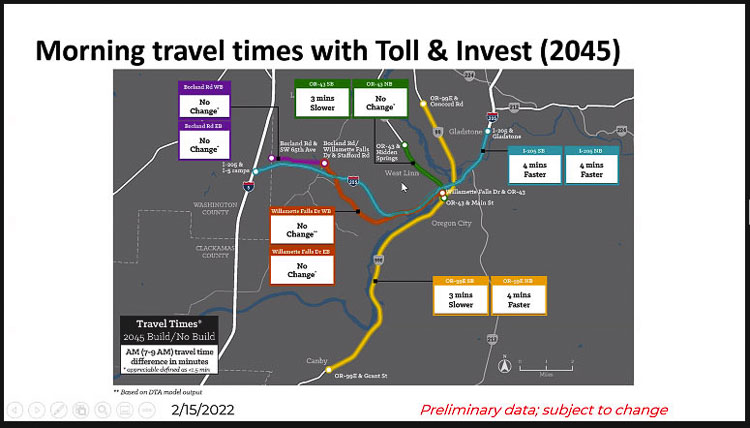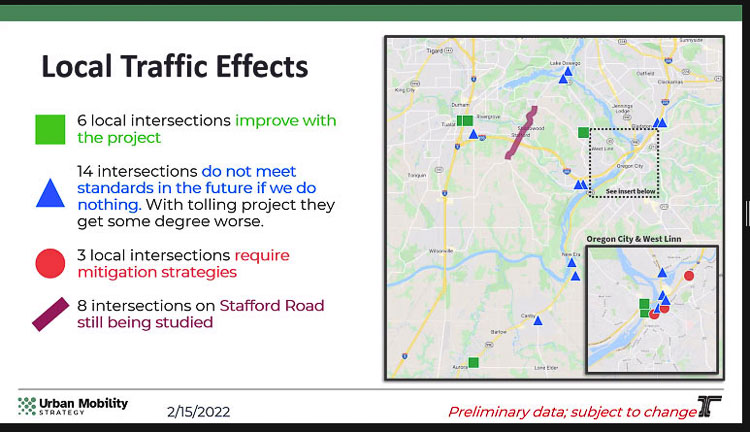No data available on the impact of simply adding new lanes, without tolling
Interstate 205 near Oregon City and West Linn is currently congested six and three quarters hours a day. In simple terms, there is more demand for freeway travel than there is supply. It’s been 40 years since I-205 opened and vehicle capacity was added to the region. Clackamas County’s population has nearly doubled. The Abernethy Bridge is part of the only two-lane section of I-205 in Oregon.
By 2045, Oregon Department of Transportation (ODOT) and its consultants expect traffic congestion to double to 14 hours daily, if nothing is done. The ODOT analysis compares doing nothing with adding new lanes combined with tolling. The results indicate a four-minute improvement in morning commute times for I-205, no change for Willamette Falls and Boreland roads, and up to three minutes slower on portions of OR 99E and OR 45.
Oregon’s tolling programs are of concern to Clark County and Southwest Washington citizens for several reasons. First, is the fact that roughly 75,000 Washington residents work in Oregon. The variable rate tolls would create “roads for the rich” according to Vancouver Councilor Bart Hansen. Second, the Interstate Bridge Replacement Program (IBR) is planning to raise money via tolling which would be added to whatever Oregon is charging to drive in that state.
On Tuesday and Wednesday, ODOT’s Urban Mobility Office hosted two community presentations. Officials spoke about the I-205 Abernethy Bridge project and how tolls will pay for part of the project. It was originally estimated to cost $450 million when HB2017 was passed. Today, cost estimates are $700 million. The project will add one new lane in each direction for 7 miles of I-205 between Hwy 213 and Stafford Rd.

Presently, there are over 100,000 vehicles using this section of I-205 daily according to ODOT. WSP USA consultant Chris Wellander was unable to answer a simple question from the community watching the lunchtime presentation: “How many vehicles will need to be removed from traveling on I-205 in order to have the traffic flow at ‘uncongested,’ free flowing speeds?”
“I don’t have that number on the top of my head,” he said. Wellander noted “it’s a complicated project” because they are adding capacity (new lanes) and tolling. In some cases, people will divert to side roads. In other cases, particularly the real congested times, people will choose to use I-205 and pay the tolls, he said.
Staff was asked if the tolling is going to reduce the total number of vehicles on I-205. How much of the traffic that will not be on I-205 will be on the local roads? How much will simply not be traveling? Is there any data to show that there will be an actual reduction in total traffic volume?
“It didn’t affect total regional trips all that much, in terms of what our modeling shows,” Wallander said. There was some shift away from people driving alone in their cars and a 2 percent increase in transit use. A small number of people would not make the trip.
He noted that in some of the more congested times, particularly the afternoon peak, the improvements would attract more trips to I-205, taking some traffic off the local roads.
Wellander commented on people’s willingness to pay tolls. “I think the thing about adding capacity and the improvements to 205, is that you’re improving the facility, you’re making it more attractive for people to use. They’re more willing to pay a toll in that case than if there was no improvement at all,”
Staff didn’t answer a citizen follow up question. “Chris said people are willing to pay tolls if there are ‘improvements,’ i.e. new lanes. Why wouldn’t this apply to I-5 tolls?”
“The I-205 improvements project and the I-205 toll project are two components of ODOT’s urban mobility strategy,” said Mandy Putney, director of ODOT’s Urban Mobility program. The strategy also includes the I-5 Rose Quarter improvement project, the Interstate Bridge Replacement (IBR) program, and the comprehensive regional tolling program.
Putney also mentioned that I-205 is Oregon’s planned north-south disaster response corridor for a major earthquake.
ODOT’s Mandy Putney explains the impacts expected on 50 interchanges in the I-205 impact area. Six get better, 14 are worse, three need mitigation, and they are still studying another eight interchanges. Video courtesy Oregon Toll Program
“The I-205 toll project is the first step toward a regional comprehensive approach to using tolling to sustainably fund investments and manage congestion,” Putney said. “Toll revenue is needed to fund the I-205 improvements project. Variable rate tolls will be collected at this location to help manage congestion.”
“The analysis found that drivers could see a 50 percent decrease in afternoon travel time and a 25 percent decrease in the morning,” ODOT officials said. “In addition, travel times would become more reliable, and the number of crashes would shrink, improving efficiency and safety.”
A citizen asked if the federal infrastructure dollars would help pay for any of the I-205 project, and if that might impact the tolling.
Putney responded, saying the Oregon Transportation Commission is currently evaluating the federal funds and where they might be applied. She noted that no funds were earmarked for the project. “We know that even if we are able to obtain federal grant funds, or from new or existing programs that are part of the infrastructure package, we still will need tolling to complete the full seven miles of I-205 improvements,” she said.
The $1.2 trillion federal infrastructure package provided at least $5.36 billion to Oregon, according to Oregon Sen. Ron Wyden. He touted the possibility of even more being available via competitive grants. Oregon’s normal transportation spending is about $3.3 billion.
In the evening presentation a citizen asked what the administrative cost is to collect tolls, and how efficient it was to collect money for transportation. Putney responded saying tolling is an efficient way to pay for transportation. She indicated the tolling would not likely end, as it’s part of the overall plan for the region. Those decisions will be made by the Oregon Transportation Commission.
According to the technical modeling based on regionally adopted traffic data, not tolling and not building the I-205 improvements project by 2045 would result in 14 daily hours of congestion on I-205 and an increase in crashes in this region.
The best improvements by completing the project were in afternoon travel times. The northbound I-205 travel was 15 minutes faster, and southbound 7 minutes faster. Those time savings were measured from I-5 to the 82nd Drive exit in Gladstone. The best morning commute improvement was 4 minutes.
The dual initiative, adding lanes and tolling, would reduce traffic congestion to just two hours a day in the southbound direction. ODOT officials said the project would completely eliminate congestion in the northbound direction.

Another citizen asked if the improvements were made (new lanes added) but did not have tolls on the bridge, how would things work?
Again, Wellander said he didn’t have the data available. He did say tolling would help, because it would reduce the volume of vehicles on I-205. “With a variable rate toll, we can make tolls a little higher, during those times that are more congested.”
Traffic diversion concerns
Clackamas County citizens are especially concerned about the tolling. There are very few alternative ways to cross the Willamette River, for people to avoid the tolls. Limited transit service is available, and is therefore not an alternative.
ODOT is evaluating traffic impacts at about 50 interchanges. Studies found six are improved by the project and 14 interchanges will fail standards if nothing is done. Three interchanges require mitigation and another eight on Stafford Rd. are still being studied.
Earlier information provided by ODOT and hired consultants have indicated there will be significant amounts of traffic diverting onto side roads. But one problem is that these side roads are already crowded with vehicles.
“All of the alternatives slightly reduce regional VMT, (vehicle miles traveled) with the greatest decline occurring in Alternative 4 followed by Alternative 3. All alternatives also result in a shift in vehicle demand away from freeways to non-freeway routes” ODOT stated 18 months ago. These range from an increase of 94,000 to 185,000 vehicle miles traveled on side roads.
WSP USA’s Chris Wellander explains that the consultant is only comparing projected traffic impacts in 2045 of doing nothing, with the dual additions of new lanes and tolling on I-205 in the 7-mile project area. Video courtesy Oregon Toll Program
After briefing the Canby City Council on their alternatives in 2020, council members expressed dismay with all of the ODOT/WSP USA “solutions.” Council President Tim Dale stated emphatically: “you’re actually going to make things worse!”
The increased diversion and traffic congestion in small towns was predicted by both ODOT and the WSP USA consultants during the 2018 “Value Pricing” Policy Advisory Committee (PAC) meetings. The analysis indicated that 50,000 vehicles were presently diverting in the metro area (due to lack of vehicle capacity) and that tolling would increase diversion onto side roads by 80,000 vehicles, once tolling was fully implemented.
Clackamas County Commissioner Paul Savas, one of the 25 PAC members, pushed back at the time, complaining that the option that delivered the most congestion relief was not being advanced.
“There was an option that’s not being considered,’’ Savas said. “Option four, which was to build a lane on both I-5 and I-205. That was discounted and then not moving forward; not by decision to this group but by decision of the process. That clearly relieved congestion more than any other alternative, judging by the scale of grading. I think it begs the question, if we had the most ideal congestion relief project of all not moving forward, then what is the purpose of the revenue.“
In community presentations, ODOT showed significant increases in traffic on already congested side roads, due to the tolling. Eighteen months ago, ODOT admitted their “single largest concern” is traffic diversion. In their presentation regarding I-205 tolling they state:
“Perhaps the largest single concern in evaluating alternatives, is the effect on roadways in the vicinity of I 205 tolling due to local rerouting. While the complete effect on rerouting cannot be precisely identified by the regional model, (especially when also considering the potential for shifts in the time of trips or changes in destination to avoid tolls), the influence of these factors is likely to positively affect traffic operations on I-205.
Specific local congestion effects (e.g., key intersection traffic performance relative to jurisdictional mobility standards) will be assessed through the NEPA evaluation of impacts. Additional study of the effects of rerouting on local roadways will be part of subsequent analysis using the DTA modeling tool, which will provide much more detail on rerouting impacts for use in analyzing alternatives, and ultimately identifying the preferred alternative.”
In early December, the Clackamas County Commissioners held a citizen town hall to allow citizens to weigh in with their concerns regarding ODOT’s specific I-205 tolling plans. The meeting ran for over 90 minutes and as Chair Tootie Smith noted at the end, not a single person spoke in favor of the tolls. Both residents and commissioners pushed back against ODOT.




